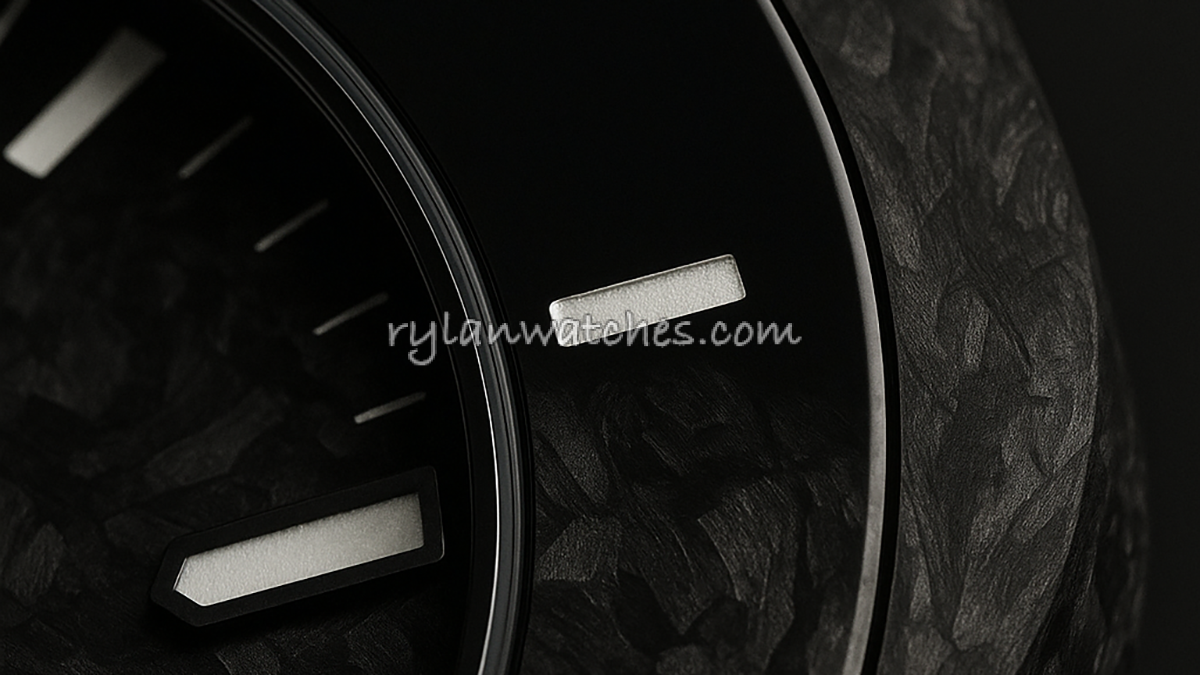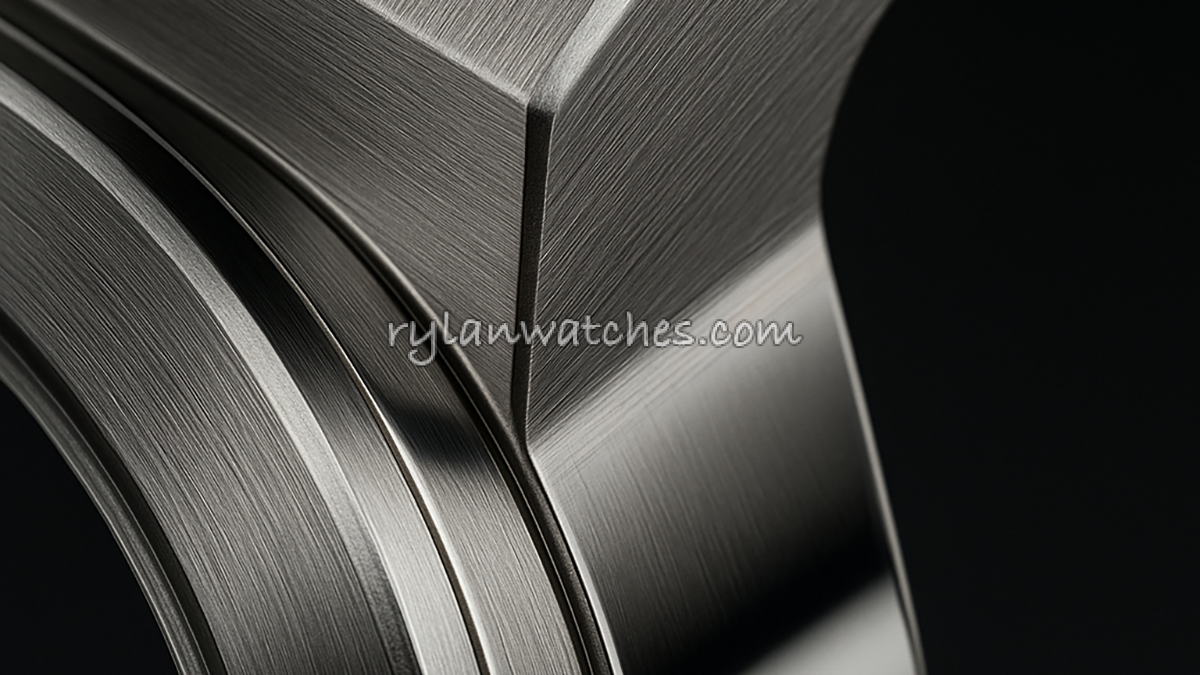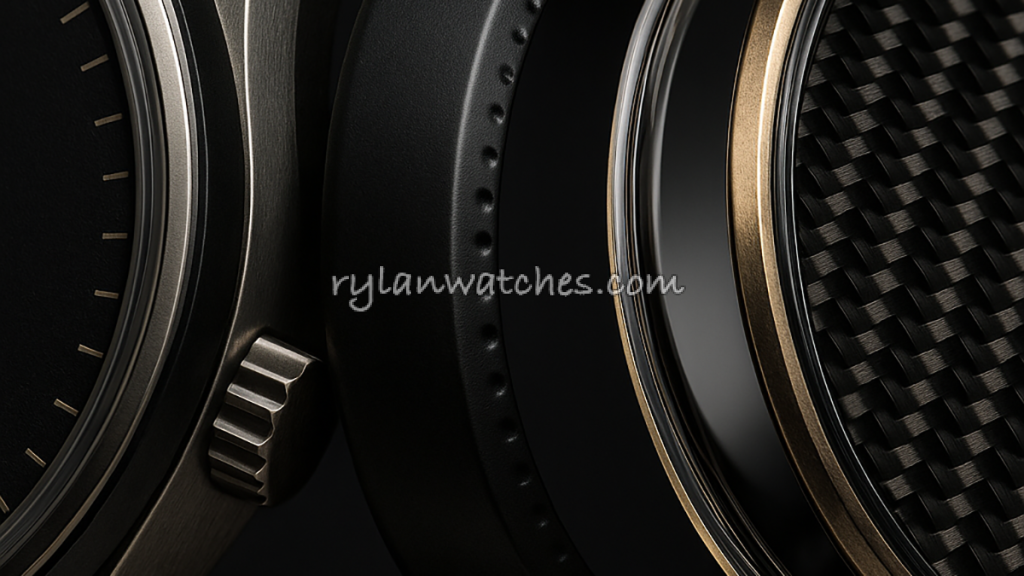Why Materials Matter in 1:1 Super Clone Watches
Understanding the materials of 1:1 super clone watches is one of the most important factors in evaluating their true quality. Collectors often focus on movements or dial accuracy, but the first impression always comes from materials—the weight of the case, the way polished steel reflects light, the density of ceramic, the clarity of sapphire, and the tactile feel of the bracelet. These elements determine whether a watch feels convincingly premium or immediately reveals itself as an ordinary replica.
Genuine Swiss watches rely on engineered alloys, advanced ceramics, sapphire crystals, and specialized rubber compounds refined over decades. Super clone manufacturers attempt to replicate these choices, but their execution varies widely. Some factories use upgraded steel, higher-grade sapphire, and improved lume formulas; others rely on softer metals, mineral glass, or thin coatings that wear quickly. This gap in material quality is the core difference between a high-level 1:1 super clone and a basic imitation.
From a practical standpoint, materials influence durability, scratch resistance, corrosion behavior, and how the watch ages in daily use. A well-constructed super clone should not only match the original visually but behave similarly on the wrist. This is why informed buyers increasingly ask deeper technical questions: is the case made from 316L or 904L steel, is the bezel genuine ceramic, is the crystal true sapphire, and how is the gold tone applied?
In this article, we explore the full spectrum of materials used in modern 1:1 super clone watches—including metals, ceramics, crystals, dials, straps, and lume compounds—and compare them with genuine Swiss standards. For readers who want to go beyond surface impressions, material knowledge remains one of the most powerful tools in assessing quality, supported by broader guides such as super clone vs replica comparisons.
Case Metals: 316L, “904L Style” Steel and Beyond
When examining the materials of 1:1 super clone watches, the case metal is one of the most influential components. Most high-quality super clone cases are crafted from stainless steel, yet not all steel behaves or ages the same way. Entry-level replicas often rely on softer, lower-grade alloys that scratch easily and feel noticeably lighter in the hand. By contrast, premium factories typically use 316L stainless steel, the same category of steel widely used in genuine Swiss timepieces thanks to its corrosion resistance, hypoallergenic properties, and balanced hardness. Properly finished 316L delivers convincing weight, sharp transitions, and a solid wrist presence that aligns with what buyers expect from higher-grade case materials in super clone watches.
Some factories have introduced what they call “904L style” or “904L equivalent” steel, intended to echo the alloy employed by certain luxury brands. True 904L stainless steel has a distinctive chemical composition, increased corrosion resistance, and a brighter, more lustrous finish. However, machining and polishing 904L require more sophisticated equipment and tighter tolerances. In the world of super clones, claims of 904L are not always substantiated through testing. For buyers, the decisive factor is less the marketing terminology and more how the case behaves in daily wear—whether it maintains polish integrity, resists micro-scratches, and preserves its sheen without developing dull or uneven patches.
Beyond steel, the materials used in 1:1 super clone watches increasingly include alternatives such as titanium and bronze-style alloys. Titanium offers a distinctive wearing experience: lighter, warmer to the touch, and highly resistant to corrosion. However, its matte surface and machining traits expose any finishing shortcomings quickly, revealing differences between factories. Bronze-inspired clones, on the other hand, often use coated brass or treated base metals meant to imitate organic patina. While visually appealing, these materials require careful evaluation, particularly when a seller provides vague or inconsistent descriptions of the underlying alloy.
Gold-tone 1:1 super clones typically rely on PVD or IP coatings applied over steel rather than solid precious metal. The realism and longevity of these coatings depend heavily on the deposition method and thickness. High-quality coatings present a warm, uniform tone that withstands years of regular wear, while lower-grade finishes may fade quickly or show abrasion along clasp edges and bracelet corners. When comparing gold-colored models, buyers should rely more on macro photography and user feedback than on naming conventions alone. Platforms that curate transparent visual references—such as Patek Philippe clone collections—can help frame expectations and distinguish durable finishes from superficial surface treatments.
Understanding case-metal choices is a key step in recognizing whether a watch truly represents the upper tier of modern clones. As factories diversify their alloys and finishing methods, material awareness becomes an essential part of evaluating quality and distinguishing reliable engineering from cosmetic imitation.
Bezels: Aluminum Inserts, Ceramic Rings and Carbon Composites
Among all the materials of 1:1 super clone watches, the bezel often creates the strongest first impression. It frames the dial, defines the watch’s character, and signals whether a clone captures the tactile realism of a genuine model. Traditional dive and GMT watches historically used anodized aluminum inserts, which remain popular in lower-cost replicas due to their affordability and ease of machining. Aluminum offers clean engraving and a wide color range, but it is also more vulnerable to scratches, UV fading, and chemical wear—traits that become visible more quickly in daily use.
As luxury brands moved toward ceramic bezels for enhanced scratch-resistance, long-term color stability, and the deep gloss associated with modern tool watches, high-end super clones followed suit. Ceramic rings in quality clones often feature engraved and paint-filled numerals, distinct transitions between polished and matte surfaces, and a weight distribution close to genuine references. Poorly executed ceramic imitators, however, appear flat, lack depth under direct light, or show softened engraving—revealing clear differences in bezel materials in 1:1 super clone watches.
A more advanced subset of super clones uses forged carbon or carbon composite bezels, especially in racing-inspired, skeletonized, or avant-garde designs. These materials combine layered carbon fibers with resin, producing organic marbling that shifts with light. The realism of a carbon bezel depends on the authenticity of its texture, the sharpness of its edge finishing, and its resistance to chipping around high-stress points. Because carbon machining requires precision equipment, inconsistent patterns or rough transitions expose gaps between factories—making carbon one of the most revealing materials used in high-end super clone bezels.
In practical evaluation, buyers should consider how each bezel material behaves over time rather than relying solely on marketing labels. Ceramic delivers exceptional scratch-resistance but can fracture under direct impact; aluminum wears gracefully but fades faster; carbon offers lightweight aesthetics yet demands precise execution. Macro photography, wrist shots, and long-term user feedback—like those often referenced in structured category pages such as Rolex clone collections—are far more reliable indicators of quality than terminology alone.
Understanding bezel construction within the broader context of materials used in 1:1 super clone watches helps buyers judge authenticity more accurately. A well-made bezel not only enhances visual fidelity but contributes to durability, balance, and daily-wear confidence—key factors in determining whether a clone truly performs at a high standard.

Crystals: Mineral vs Sapphire and AR Coatings
The crystal is the transparent barrier between the outside world and the dial. In the super clone segment, the main distinction is between mineral glass and sapphire crystal. Lower-cost replicas frequently use hardened mineral glass, which is serviceable but more prone to scratching. High-end 1:1 super clone watches generally feature sapphire crystal, the same material used in genuine Swiss models, valued for its excellent scratch-resistance and optical clarity.
Sapphire is significantly harder than mineral glass, which means it is much less likely to pick up scratches from daily wear. However, it is not completely immune to damage; sharp impacts and certain abrasives can still cause chips. In high-quality super clones, the edge finishing of the sapphire—whether flat, domed, or box-shaped—should closely follow the genuine design, including how it reflects light around the dial’s perimeter.
Many modern watches, both genuine and cloned, apply anti-reflective (AR) coatings to improve legibility. Some brands coat only the underside of the crystal, while others apply AR to both sides, which gives a distinctive “ink on dial” look but is more vulnerable to superficial scratches on the outer layer. Factories that take AR seriously can deliver a surprisingly authentic dial experience, especially in bright conditions. Those that do not may produce crystals that look overly reflective or slightly “milky” in certain angles.
When evaluating a 1:1 super clone crystal, buyers should examine how the dial appears under different lighting conditions, whether distortion at extreme angles matches the original, and if the date magnifier (where applicable) has accurate magnification and alignment. Subtle differences in crystal execution can strongly influence how “expensive” or “cheap” a watch feels, even when the rest of the case is well made.
Dials, Hands and Lume: The Micro-World of Surfaces
Beneath the crystal lies the most scrutinized area of any super clone: the dial and hands. Most quality 1:1 super clones use brass dial blanks with layered finishes—sunburst brushing, lacquer, matte textures, or applied indices—to approximate genuine designs. The precision of printing, alignment of markers, and clean edges around apertures are often more important than the exact base material, because the human eye instantly notices anything crooked or fuzzy.
Hands in good super clones are typically made from plated brass or steel, with polished or brushed surfaces that catch light cleanly. Poorer hands reveal themselves through uneven polishing, bent tips, or lume that spills over the edges. On more advanced pieces, factories attempt complex finishes such as gradient fumé dials or skeletonized hands. These are difficult to execute, and small flaws become obvious in macro photos, which is why experienced buyers carefully inspect real-life images before ordering.
Lume compounds, often inspired by Super-LumiNova-style pigments, play a major role in nighttime legibility. High-end clones use stronger luminous material, applied generously and evenly in plots and hand cavities. Cheaper replicas may use weak or inconsistent lume that glows briefly and fades quickly. While most factories will not disclose the exact lume formula, you can often gauge quality from owner photos and side-by-side comparisons in watch forums and technical articles on reputable sources such as WatchTime.
Ultimately, the dial and hands are where materials intersect with execution. The best 1:1 super clone watches combine solid base materials with careful finishing, producing layers of reflection and depth that look convincing in everyday use. If the dial appears flat, the printing coarse, or the lume patchy, no amount of marketing can compensate; the illusion of luxury depends on the micro-world that lives under the crystal.
Bracelets, Clasps and Straps: Steel, Rubber and Leather
Bracelets and straps are the main point of contact between the watch and the wearer, and they are often where lower-grade replicas reveal themselves first. High-end 1:1 super clone bracelets are usually crafted from solid stainless-steel links rather than folded or hollow pieces. The tolerances between links, the smoothness of articulation, and the sharpness of chamfered edges all contribute to how “premium” the bracelet feels when it flexes and wraps around the wrist.
Clasp construction is particularly important. Better super clones feature milled clasps with secure micro-adjustments, firm closing action, and precise engravings. Cheaper replicas often use stamped components that feel thin, rattle when moved, or show rough edges. Because clasps are subject to frequent opening and closing, the choice of metal and the robustness of springs and hinges directly affect long-term reliability.
Rubber and composite straps in modern super clones attempt to emulate the soft-touch, high-memory materials used by genuine luxury brands. Good examples feel supple yet dense, without a plasticky sheen or overpowering smell. Poor compounds can crack at stress points or become sticky over time. On the leather side, factories may use genuine leather, corrected grain, or synthetic materials; stitching quality, lining feel, and edge finishing are usually more telling than the label alone.
For buyers comparing models on different platforms, it is helpful to focus on real-life wrist shots and close-up photos of links, end links, and clasp interiors. Structured category pages, such as Rolex clone watch collections, can provide a visual reference for how bracelets and clasps are presented by sellers that take material quality seriously.

Water Resistance, Gaskets and the Limits of Clone Engineering
Among all the materials of 1:1 super clone watches, water-resistance components—gaskets, seals, crown tubes, and case machining tolerances—are the most misunderstood. Even well-made super clones must be approached realistically. Genuine dive watches rely on tightly engineered tolerances, high-grade gasket materials, and rigorous assembly controls. While premium factories upgrade seals and use reliable screw-down crowns, the consistency of pressure testing seldom reaches the level maintained by major Swiss brands. For this reason, most experienced collectors treat super clones as “everyday resistant” rather than expecting them to meet the depth ratings printed on the dial.
Gaskets in super clones are typically formed from rubber or synthetic compounds engineered to compress and seal casebacks, crowns, and pushers. In higher-quality examples, these gaskets are properly lubricated and seated within precisely machined grooves. In weaker clones, gaskets may arrive dry, loosely positioned, or produced from lower-grade materials that degrade faster under heat, sweat, or moisture exposure. Even when construction appears promising, reliable verification still requires proper pressure testing performed by a qualified watchmaker—one of the clearest ways to assess water-resistance materials in super clone cases.
From a material engineering perspective, understanding these limitations prevents unrealistic expectations. A watch may feature solid stainless steel, sapphire crystal, and ceramic inserts, yet still remain vulnerable at the crown tube, pusher seals, or caseback gasket—areas where even slight inconsistencies compromise overall resistance. Sellers who communicate these realities transparently, advising buyers to avoid hot showers, saunas, or unnecessary submersion, tend to demonstrate a more responsible approach to the material limitations in 1:1 super clone watches.
In practical usage, it is best to view water resistance as a protective layer rather than a challenge to be tested. Ceramic bezels, sapphire crystals, and robust steel cases all contribute to durability, but seals remain the weakest and most variable component in clone engineering. For buyers who swim or dive regularly, pairing a super clone with a fully tested, purpose-built tool watch—not relying on optimistic clone specifications—provides the safest and most realistic long-term solution.
How Material Choices Help You Judge a True 1:1 Super Clone
Material knowledge transforms the way you evaluate super clone watches. Instead of relying only on photos or brand names, you begin to see patterns: whether a factory consistently uses sapphire instead of mineral glass, whether bracelets are solid or hollow, whether coatings hold up over time, and whether ceramic or carbon parts are executed cleanly. These observations allow you to distinguish a genuinely high-grade 1:1 super clone from a piece that is visually appealing but structurally compromised.
For buyers comparing platforms, it is useful to combine this material awareness with broader due diligence. How does a seller describe metals and crystals? Do they provide macro photography of bezels, dials, and clasps? Are they transparent about water-resistance limitations and movement differences? Articles that analyze the market structure—such as guides to safe super clone buying—pair well with a material-focused perspective, giving you both strategic and technical insight.
In the end, the most convincing 1:1 super clone watches are those where material choices and finishing discipline align. Steel feels dense and well-shaped, ceramic or carbon parts are crisp, sapphire crystals remain clear, bracelets articulate smoothly, and lume behaves predictably. When these elements come together, the watch stops feeling like an imitation and starts functioning as a reliable daily companion, even if it will never be a genuine Swiss original.
By looking “inside the materials,” you move beyond surface impressions and marketing phrases. You gain a practical framework for judging quality, asking better questions, and choosing pieces that reward long-term wear. For collectors and first-time buyers alike, this deeper understanding is one of the most powerful advantages you can bring to the world of 1:1 super clone watches.

